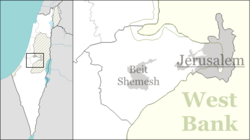Mata(moshav)
| Mata | |
|---|---|
 |
|
| Coordinates: 31°43′3.72″N 35°3′44.28″E / 31.7177000°N 35.0623000°ECoordinates: 31°43′3.72″N 35°3′44.28″E / 31.7177000°N 35.0623000°E | |
| District | Jerusalem |
| Council | Mateh Yehuda |
| Affiliation | Moshavim Movement |
| Founded | 1950 |
| Founded by | Yemenite Jews |
| Population (2015) | 897 |
Mata (Hebrew: מַטָּע, lit. Grove) is a moshav in central Israel. Located in the Jerusalem corridor near Beit Shemesh, it falls under the jurisdiction of Mateh Yehuda Regional Council. In 2015 it had a population of 897.
"The name mata is also hinted at in Ezekiel (XXXIV, 29)": I will provide for them a grove.
The village was established in 1950 by immigrants from Yemen on land which had formerly belonged to the depopulated Arab village of Allar. After two Yemenite Jews were murdered by local Arabs, the Yemenite community eventually moved to more populated areas of Petah Tikva and Karkur. The founders were later joined by more immigrants from Morocco. Tobacco was once grown there by the early residents, but this has been replaced by grape vineyards.
Along the old Roman Road (now regional highway 375) are the ruins of a travelers' inn and livery stable, now called "khanut" (formerly, Khirbet el-Khan). It was described by Edward Robinson in 1838, in his Biblical Researches in Palestine. A mosaic floor with Greek writing of a Byzantine type can still be seen in the remains of the structure, believed to have been used as a church.
In the 12th century, a rural monastery was established there by the Crusaders consisting of several barrel-vaulted buildings, an enclosure wall and a chapel. British archaeologist Denys Pringle proposed that the complex was a Cistercian house called "Saluatio" established in 1169.
In the valley are various types of trees: Sweet and bitter almonds, olives, grapes, pomegranates, lemons, figs, walnuts, Syrian pears, carobs and hawthorns. To the south-east of the moshav is a natural spring called `Ain Jerash named after a nearby small Arab village (now abandoned) and which was built on a spur near the town of Tzur Hadassah (Har Kitron). Rock-carved niches used as tombs can still be seen in the abandoned village.
...
Wikipedia

